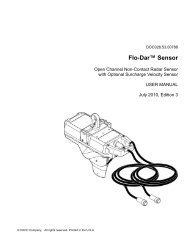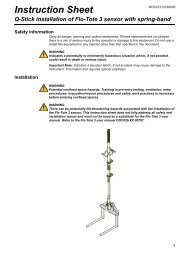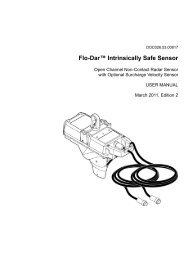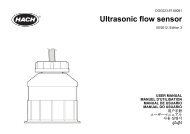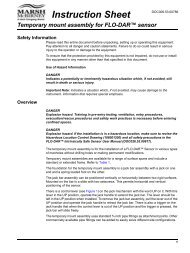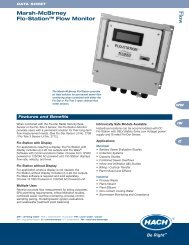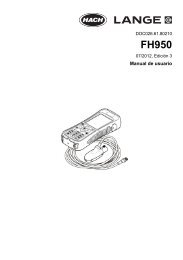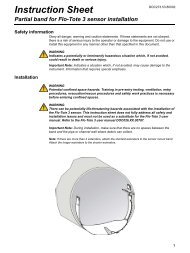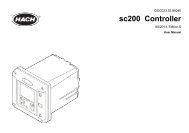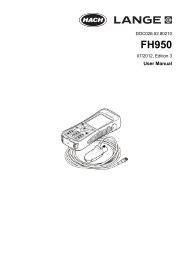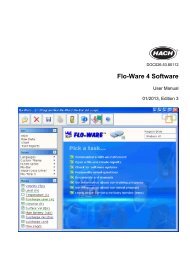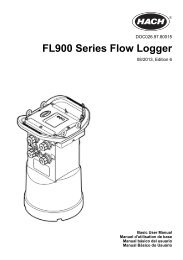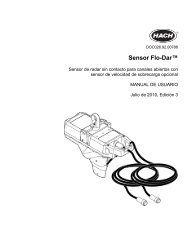Antennas for Flow Products Installation Sheet - Hachflow
Antennas for Flow Products Installation Sheet - Hachflow
Antennas for Flow Products Installation Sheet - Hachflow
You also want an ePaper? Increase the reach of your titles
YUMPU automatically turns print PDFs into web optimized ePapers that Google loves.
User Instructions<br />
<strong>Antennas</strong> <strong>for</strong> flow products<br />
Precautionary labels<br />
Read all labels and tags attached to the instrument. Personal injury or damage to the<br />
instrument could occur if not observed.<br />
Electrical equipment marked with this symbol may not be disposed of in European public disposal systems after 12<br />
August of 2005. In con<strong>for</strong>mity with European local and national regulations (EU Directive 2002/98/EC), European<br />
electrical equipment users must now return old or end-of-life equipment to the Producer <strong>for</strong> disposal at no charge to<br />
the user.<br />
Note: For return <strong>for</strong> recycling, please contact the equipment producer or supplier <strong>for</strong> instructions on how to return end-of-life<br />
equipment, producer-supplied electrical accessories, and all auxillary items <strong>for</strong> proper disposal.<br />
Product components<br />
Required equipment/software<br />
FL900 Series <strong>Flow</strong> Logger<br />
Verify the telemetry (wireless option)<br />
Make sure that all components have been received. If any items are missing or damaged,<br />
contact the manufacturer or a sales representative immediately.<br />
Make sure that the following requirements are available:<br />
• FL900 Series flow logger with modem option or Sigma 930T<br />
• Remote host computer operating FSDATA or Telogers <strong>for</strong> Windows server software<br />
• Portable computer operating FSDATA, FloWare or Telogers <strong>for</strong> Windows<br />
• Activated wireless account<br />
The user can manually send a call to the server to make sure that the network<br />
communication is good.<br />
1. Temporarily attach the antenna to the logger to test the antenna and the cell coverage<br />
at the site location be<strong>for</strong>e installation.<br />
2. Touch the magnet to the call initiation target (Figure 1). The modem LED indicator<br />
changes to green.<br />
3. Look at the modem LED indicator during the call (45 to 90 seconds) and wait <strong>for</strong> a<br />
change:<br />
• LED goes off—the connection to the server is good.<br />
• LED flashes red—the connection to the server failed.<br />
Note: If the connection failed, refer to the instrument user manual <strong>for</strong> more in<strong>for</strong>mation.<br />
1
Figure 1 Call the server<br />
1 Call initiation target 2 Magnet<br />
930T <strong>Flow</strong> meter<br />
Verify the wireless connection<br />
The tamper button is used to examine if the wireless connection is working.<br />
1. Temporarily attach the antenna to the logger to test the antenna and the cell coverage<br />
at the site location be<strong>for</strong>e installation.<br />
2. Attach the tamper module to the RS232 connector on the flow meter (Figure 2).<br />
3. Push the tamper button to start a cellular call from the flow meter to the remote host<br />
computer.<br />
4. Go to the event log in Telogers <strong>for</strong> Windows to make sure that the data was successfully<br />
downloaded from the flow meter to the remote host computer. Refer to the 930T<br />
documentation <strong>for</strong> further in<strong>for</strong>mation about telemetry troubleshooting.<br />
Figure 2 Tamper module connected to the 930T <strong>Flow</strong> meter<br />
1 RS232 connector 2 Tamper module<br />
2
<strong>Installation</strong><br />
W A R N I N G<br />
Electromagnetic radiation hazard. To meet the requirements of the FCC Grant, CE Mark and other<br />
regulatory bodies, do not use or install the device with an antenna that is not supplied by the<br />
manufacturer. Make sure that all antennas are kept at a minimum distance of 20 cm (7.9 in.) from<br />
all personnel in normal use.<br />
N O T I C E<br />
Test the antenna and cell coverage at the site location be<strong>for</strong>e installation.<br />
N O T I C E<br />
Make sure that the flow meter is programmed to call the host PC be<strong>for</strong>e installation.<br />
Half wave antenna<br />
N O T I C E<br />
The half wave antenna is intended <strong>for</strong> above-ground use.<br />
1. Unpack the antenna (Figure 3).<br />
2. Bend the antenna at the joint to a 90 degree angle between the antenna and the swivel<br />
fitting.<br />
3. Put the antenna extension inside of the logger handle (Figure 4).<br />
4. Align the threads from the antenna fitting to the antenna receptacle on the logger. Handtighten<br />
by turning the swivel end.<br />
Figure 3 Half wave antenna<br />
Figure 4 Half wave antenna attached<br />
3
Traffic rated manhole lid antenna<br />
Required tools:<br />
• 31.75 mm (1¼ in.) open-end wrench<br />
• Large nylon Ty-wrap cable ties<br />
1. Unpack the antenna (Figure 5) or disassemble the antenna from the instrument.<br />
2. Make sure that the manhole lid has a 25.4 mm (1 in.) hole <strong>for</strong> the antenna neck to fit<br />
into.<br />
Note: Do not use the pick hole. Use a drill, motor oil <strong>for</strong> lubrication and increasing size drill bits<br />
to drill the 25.4 mm (1 in.) hole if needed. Make sure that the location of the hole does not coincide<br />
with the ribs on the underside of the manhole lid.<br />
3. Remove the manhole lid and put the lid in a stable position where the lid top and bottom<br />
are accessible.<br />
4. Remove the nut and washers from the threaded neck on the base of the antenna<br />
(Figure 6).<br />
5. Put the antenna cable and neck through a hole on the manhole lid until the base of the<br />
antenna is against the top of the manhole lid.<br />
6. Install the flat washer, then the lock washer and then the nut on to the threaded neck<br />
of the antenna.<br />
7. Tighten the nut with the open-end wrench until both washers are flush against the base<br />
of the manhole lid and the antenna is tight (Figure 6).<br />
8. Connect the antenna cable to the instrument connector labeled "Antenna". To make<br />
sure proper transmission, hand-tighten the connections.<br />
9. Attach any excess cable to the access ladder or another non-obstructing location with<br />
Ty-wrap cable ties.<br />
10. Replace the manhole lid.<br />
Figure 5 Traffic rated manhole lid antenna<br />
4
Figure 6 Manhole lid installation<br />
1 Antenna top 5 Antenna cable<br />
2 Manhole lid 6 Antenna threaded neck<br />
3 Flat washer 7 Lock washer<br />
4 31.75 mm (1¼ in.) nut<br />
Wing Quad antenna<br />
The Wing Quad antenna can be attached to an interior wall or to a window <strong>for</strong> a longer term<br />
deployment or the antenna can be attached to a manhole lid <strong>for</strong> a short term deployment.<br />
Required tools:<br />
• Large nylon Ty-wrap cable ties<br />
1. Unpack the antenna (Figure 7).<br />
2. To attach the antenna to a window or a wall, remove the adhesive backing and push<br />
the antenna to a clean surface.<br />
3. To attach the antenna to a manhole, make sure that the manhole lid has a hole large<br />
enough <strong>for</strong> the antenna connector to fit into.<br />
Note: Do not use the pick hole. Use a drill, motor oil <strong>for</strong> lubrication and increasing size drill bits<br />
to drill the 1" hole if needed. Make sure that the location of the hole does not coincide with the<br />
ribs on the underside of the manhole lid.<br />
4. Remove the manhole lid and put the lid in a stable position where the lid top and bottom<br />
are accessible.<br />
5. Put the antenna cable and neck through a hole on the manhole lid until the base of the<br />
antenna is against the top of the manhole lid.<br />
6. Attach the antenna to the manhole lid with heavy tape or tar tape.<br />
7. Connect the antenna cable to the instrument connector labeled "Antenna". To make<br />
sure proper transmission, hand-tighten the connections.<br />
8. Attach any excess cable to the access ladder or another non-obstructing location with<br />
Ty-wrap cable ties.<br />
9. Replace the manhole lid.<br />
5
Figure 7 Wing Quad antenna<br />
Traffic rated in-road/burial antenna<br />
Required tools:<br />
• Asphalt saw or auger: saw capable of cutting 127 mm (5 in.) in diameter and 76.2 mm<br />
(3 in.) deep into a road surface or ground<br />
• Asphalt chisel<br />
• Hammer drill with 19.1 to 25.4 mm (¾ to 1 in.) asphalt drill bit (<strong>for</strong> antenna cable<br />
installation)<br />
• Sakrete asphalt mix (Asphalt patch)<br />
• Bondo; Mar-Hyde P606 Traffic Detector Wire Loop Sealer or equal<br />
• Shovel, if placing in the ground<br />
The traffic rated in-road/burial antenna is intended <strong>for</strong> burial beneath the road surface or<br />
ground adjacent to a manhole or vault that is being monitored (Figure 9).<br />
N O T I C E<br />
The antenna should be installed in the road approximately 152.4 to 203.2 mm (6 to 8 in.) inches from<br />
the manhole or vault containing the flow meter.<br />
1. Unpack the antenna (Figure 8) or disassemble the antenna from the instrument.<br />
2. Excavate a hole or trench in the road surface or ground approximately 127 mm (5 in.)<br />
in diameter (or square) and 76.2 mm (3 in.) deep.<br />
3. Select the closest position from the excavated hole to the manhole. Drill a 19.1 to 25.4<br />
mm (¾ to 1 in.) hole from the selected position to the manhole. Make sure to drill the<br />
hole below the steel manhole cover support ring (Figure 9, List item. on page 7).<br />
4. Put the antenna cable through the drill hole into the manhole or vault.<br />
5. Install the antenna in the excavated hole. Pull the antenna cable taut. Locate the<br />
antenna so that the ceramic side of the antenna is approximately 6.4 (¼ in.) to 12.7 mm<br />
(½ in.) maximum below the road or ground surface. Make sure the antenna sits safely<br />
in the hole.<br />
6. Attach the antenna cable to the antenna connector.<br />
7. Make sure that the antenna is working by placing a call from the instrument (refer to<br />
Verify the wireless connection on page 2).<br />
8. When the operation of the antenna is confirmed, permanently bury the antenna.<br />
a. Insert asphalt mix around the antenna and pack it in place. Make sure the antenna<br />
is sitting firmly on a solid base and cannot be rocked back and <strong>for</strong>th.<br />
b. Install the asphalt mix around the antenna. The mix should be level with the road<br />
surface but not over the antenna surface.<br />
c. Pour the Bondo sealer on and over the asphalt mix and over the top of the antenna.<br />
There should be no more than 6.4 mm (¼ in.) of Bondo sealer over the top of the<br />
antenna.<br />
6
d. Connect the desired sensors and options to the flow meter. Calibrate the sensors<br />
and install the flow meter in the manhole.<br />
Figure 8 Burial antennas<br />
1 Traffic rated in-road/burial antenna (Verizon) 2 Traffic rated in-road/burial antenna (Sprint)<br />
Figure 9 Burial antenna assembly<br />
1 Manhole cover 4 Trench or hole <strong>for</strong> antenna<br />
2 19.1 to 25.4 mm (¾ to 1 in.) hole 5 Antenna cable<br />
3 Antenna 6 <strong>Flow</strong> meter<br />
7
Replacement Parts<br />
Note: Product and Article numbers may vary <strong>for</strong> some selling regions. Contact the appropriate<br />
distributor or refer to the company website <strong>for</strong> contact in<strong>for</strong>mation.<br />
Description<br />
Item no.<br />
Half wave, 824-894 & 1850-1990 MHz, 3 dBi 5228400<br />
Half wave European, 870-960 & 1710-1880 MHz, 3dBi 5255300<br />
Traffic rated manhole lid quad, 824-896 & 1850-1990 MHz, 3 dBi 5255400<br />
Wing Quad, 824-960 & 1710-2170 MHz, 2.15 dBi 6241804<br />
Traffic rated in-road/burial antenna (Verizon), 824-896 MHz, 3 dBi 6246200<br />
Traffic rated in-road/burial antenna (Sprint), 1850-1990 MHz, 3 dBi 6683000<br />
www.hachflow.com<br />
© Hach Company, 2010. All rights reserved. Printed in the U.S.A. 08/2010, Edition 1



